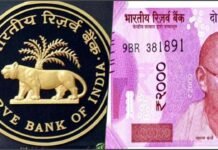
Key points
- Only 1.67% of original ₹3.56 lakh crore worth of Rs 2,000 notes remain uncollected; circulation dropped from ₹3.56 lakh crore to ₹5,956 crore.
- Notes remain legal tender but cannot be used for regular transactions; banks stopped accepting them after October 7, 2023, but RBI’s 19 issue offices continue exchanges.
- Citizens can deposit notes at RBI offices in major cities or send them via India Post from any post office nationwide for direct bank account credit.
- Rs 2,000 notes were introduced post-demonetization in November 2016 but printing stopped in 2018-19 as they fulfilled their emergency purpose.
New Delhi: Rs 2,000 notes worth ₹5,956 crore remain in circulation as of August 31, 2025 over two years after the RBI announced their withdrawal in May 2023 but 98.33% of the notes have been successfully returned to the banking system, with exchange facilities still operating at 19 RBI offices and through India Post.
Current circulation status and withdrawal progress
The Reserve Bank of India released official data showing that ₹5,956 crore worth of Rs 2,000 notes remain in public circulation as of August 31, 2025, representing just 1.67% of the original ₹3.56 lakh crore that was circulating when the withdrawal was announced on May 19, 2023. This marks a successful 98.33% return rate, with the withdrawal process showing steady progress since the announcement—from 93% returned by August 2023 to the current near-complete collection.
The gradual decline has been consistent, with circulation dropping to ₹6,181 crore by May 2025 and further reducing to ₹5,956 crore by August 2025, indicating continued public compliance despite the notes remaining legal tender.
Where and how to exchange remaining notes
RBI Issue Offices: Citizens can exchange Rs 2,000 notes at any of the 19 designated RBI issue offices located in Ahmedabad, Bengaluru, Belapur, Bhopal, Bhubaneswar, Chandigarh, Chennai, Guwahati, Hyderabad, Jaipur, Jammu, Kanpur, Kolkata, Lucknow, Mumbai, Nagpur, New Delhi, Patna, and Thiruvananthapuram.
Exchange limits and requirements: Individuals can exchange up to ₹20,000 worth of notes per visit with mandatory identity proof such as Aadhaar or PAN card. For deposits exceeding ₹50,000 in a single day, PAN number quotation becomes mandatory under Income Tax Rule 114B.
India Post facility: A unique feature allows people to send Rs 2,000 notes from any post office across the country to RBI issue offices for direct credit to their bank accounts, particularly beneficial for those in rural or remote areas.
Legal status and transaction limitations
While Rs 2,000 notes continue to be legal tender in 2025, they face practical restrictions in daily use. Most businesses and shops hesitate to accept these notes due to fear of being stuck with currency that others won’t accept and difficulty in providing change for smaller purchases.
Regular bank branches stopped accepting Rs 2,000 notes for deposit or exchange after October 7, 2023, making the RBI’s specialized facilities the only official avenue for conversion. The notes technically can be used for payments, but their acceptance depends entirely on the willingness of the recipient.
Why Rs 2,000 notes were discontinued
The Rs 2,000 note was introduced in November 2016 under Section 24(1) of the RBI Act primarily to address the immediate currency shortage following the demonetization of ₹500 and ₹1,000 notes. About 89% of these notes were issued before March 2017, and printing was discontinued in 2018-19 once adequate supplies of other denominations became available.
The RBI cited the “Clean Note Policy” as the primary reason for withdrawal, noting that most Rs 2,000 notes had reached or exceeded their estimated lifespan of 4-5 years. By March 2023, these notes constituted only 10.8% of total currency in circulation, with limited use in daily transactions making their withdrawal logical.
Timeline and deposit phases
| Phase | Activity | Duration | Status |
|---|---|---|---|
| Phase 1 | Deposit/exchange at any bank branch | May 23 – September 30, 2023 | Completed |
| Phase 2 | Extended bank facility | Until October 7, 2023 | Completed |
| Ongoing | RBI offices and India Post only | October 9, 2023 onwards | Active |
The phased approach ensured maximum public convenience, with an initial four-month window for bank deposits followed by the current specialized facility system that continues without a specified end date.
Future outlook and recommendations
Financial experts suggest that the near-complete withdrawal is unlikely to disrupt cash-based sectors, as ₹500 notes and digital payments have become dominant. However, holders of remaining Rs 2,000 notes face the risk of future complete demonetization, making early exchange advisable to avoid potential complications.
The RBI continues to monitor the situation and may announce further measures if circulation doesn’t reduce significantly, though no immediate deadline for complete withdrawal has been declared. The success of the voluntary withdrawal process demonstrates effective currency management and public cooperation in India’s evolving monetary landscape.













































